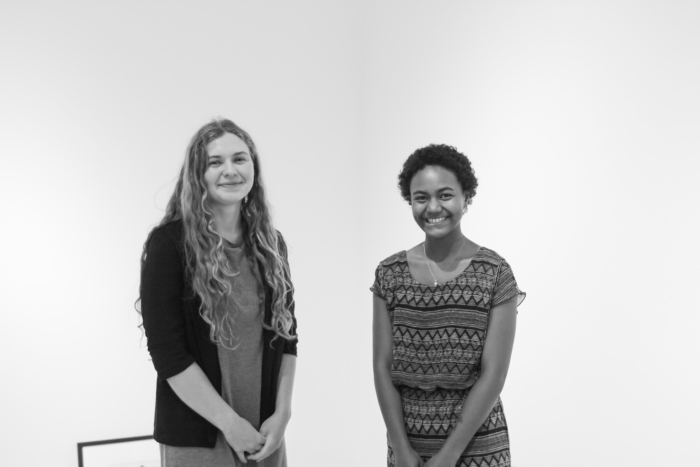
This past fall, as a first-year at Scripps, Gillian Holzer ’19 could not have imagined she’d be spending the summer immersed in Parisian poster art from the 1890s. But discovering the black-and-white drawings of Aubrey Beardsley, a controversial figure in the Art Nouveau movement, has been just one of many surprises that’s come from her experience as one of six summer interns at the Ruth Chandler Williamson Gallery.
Holzer grew up in the tiny Missouri town of DeSoto, but her grandmother, Scripps alumna Sheila Garard Holzer ’62, took her to visit the College when she was 13. “I fell in love with the campus, and I never really looked anywhere else,” she said. (She also has a sister at Scripps, Iris Holzer ’17).
Her early fascination with art and architecture, and her love for chemistry in high school, led her to an interest in art conservation and art history. When she learned about the summer internship program at the Williamson Gallery, she jumped at the chance to apply.
As the gallery’s Peggy Phelps Intern, Holzer is working with Professor of Art Mary MacNaughton to develop wall texts and gallery talks for two upcoming exhibitions at San Antonio Gardens in Claremont and the Clark Humanities Museum at Scripps. The first exhibit, Desire & Decadence in Fin-de-Siècle Europe, will be on view from January 17 until February 24, 2017, and will run parallel to a Core II course by the same name, taught by Professor of French and Humanities Eric Haskell and MacNaughton.
“It’s been a lot of fun sifting through the Scripps and Pomona archives for this,” Holzer said.
Holzer was most struck by Beardsley’s artwork that accompanied the 1894 English translation of Oscar Wilde’s tragic play, “Salome”; the Denison Library has an original copy of the book and illustration sheets.
Holzer is also working on a spring photography exhibit of work by Michael Childers, a founding photographer of Interview magazine. She is researching and writing wall text and working directly with the artist, who is loaning works and will speak about his career of photographing iconic actors, authors, and artists, including David Hockney, Paul Newman, Rudolf Nureyev, Amy Tan, Andy Warhol, and Tennessee Williams.
In addition to the hands-on work of bringing exhibitions to life, interns participate in a series of field trips and meetings—from Getty Villa to downtown street art and many points in between—with professionals in the art world, designed to provide a survey of careers in the visual arts. They’ve spent time with leaders in public relations, arts administration, public art, art law, art auctions, conservation, and education—and even received a crash course in ceramics, where they fired and glazed their own hand-formed pots in 2,000-degree kilns, at the studio of ceramicist T Robert.
For Laura Woods ’18, a history major from Anchorage, Alaska, the combination of those real-world experiences and the chance to research and write for an upcoming exhibit has been an eye-opening introduction to the connection between art and society.
Woods, this summer’s Wilson Administrative Intern, pursued her internship after learning about it at an alumnae event at the studio of renowned artist and Scripps alumna Alison Saar ’78.
“I was inspired by how she was able to comment on Hurricane Katrina—how the black population of New Orleans was particularly devastated—through a series of female figures near or in water,” said Woods.
Woods is assisting in researching, writing interpretive wall texts, and helping with the installation of an upcoming Williamson Gallery exhibit of recent acquisitions made by the Scripps Collectors’ Circle.
Through her research for the exhibit, she’s found herself drawn to the bold colors and lively energy of “Snake Man,” a contemporary African American print by Saar, and “House of Shango,” a woodcut print by Scripps College Professor Emerita of Art Samella Lewis.
“It’s been really interesting to see how artwork reflects the social climate of its time,” she said. “That’s new to me.”

